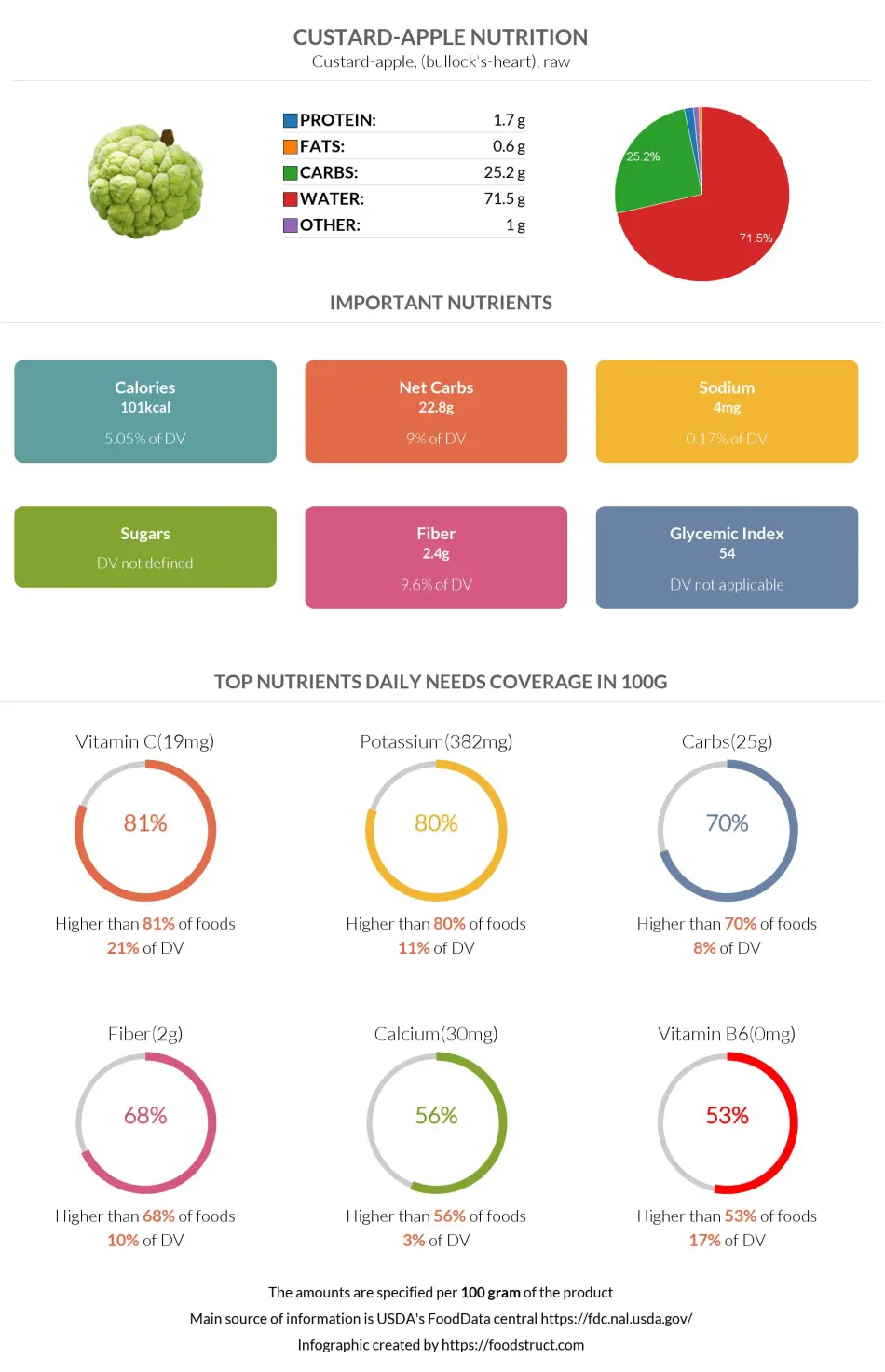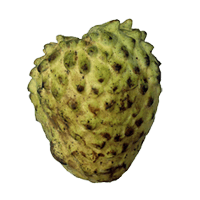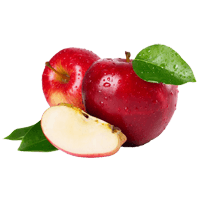Custard Apple Nutrition, Health Benefits, and Disadvantages

Introduction
Custard apple is not a very popular fruit in the culinary world. It's a sub-tropical, seasonal, and palatable fruit with many beneficial effects on human health.
Custard apple is also known as cherimoya. Due to its creamy texture, people often eat this fruit with a spoon. It also can be served chilled like custard. Custard apples have a sweet taste, similar to bananas and pineapples.
General Information
Classification
Custard-apple is a common name for a fruit that belongs to the Annonaceae family. This family contains over 2000 members. Custard apple trees are large and have drooping green leaves.
It takes between 20 and 25 weeks for this fruit to reach maturity. These fruits are widely grown in Maharashtra, India.
Appearance, Taste, and Use
Custard-apple is a green fruit with scaly skin and creamy, sweet flesh. It is important to note that dark green custard apples are unripe, while ripe custard apples are pale green.
The custard apple is a flavorful fruit, perfect as an ingredient for tea or a fruit pie. The white pulp has a ripe pear-like consistency with a subtle creamy custard flavor. The rich pulp makes the perfect apple custard cake, and its juice can be used to make delicious smoothies or shakes.
Varieties
Custard apple is a common name for over 2000 varieties of this fruit. Here are some of them:
"Tikal" is bright red except for the white areas surrounding the seeds.
"Canul" has a dark red surface and purple-red flesh; it is a very aromatic and delicious fruit.
"Sartenaya" has medium-sized fruits with a waxy and red surface flesh with excellent taste and texture.
Other well-known custard apple varieties are the Pink’s Mammoth, the Red Custard Apple, and the African Pride. All are sweet and juicy.
Cultivation
The tropical climate is ideal for growing custard apples. Dry, hot, and humid conditions promote fruit growth. You can obtain an excellent fruit yield in moderate winter conditions and high humidity. The plant does not tolerate frost and severe cold.
The ideal annual rainfall for growing a custard apple is between 500 and 800 mm. Land preparation for growing custard apples is the same as for any other fruit crop (1).
History
In ancient times, custard apples were brought across Central America to southern Mexico. They have long been cultivated and naturalized in the south, in Peru and Brazil.
The custard apple was first introduced to tropical Africa in the early 17th century and is now grown as an orchard fruit tree in South Africa.
In India, this tree is cultivated, especially in the vicinity of Calcutta, and it grows in many areas. It became pretty standard on the east coast of Malaya and is more or less everywhere in Southeast Asia and the Philippines. Eighty years ago, it was naturalized entirely in Guam (2).
Nutrition
Due to its vitamin, mineral, and macronutrient content, custard apple has many beneficial effects on our health. The nutritional information below will focus on 100g servings of raw custard apples.
Macronutrients and Calories
Custard apples are somewhat dense in nutrients, consisting of 71% water and 29% nutrients. Of these nutrients, 25% is made up of carbohydrates and 2% protein.
Macronutrients chart
Calories
Custard apples provide 101 calories per 100g serving. The central portion of the calories comes from carbohydrates. This can be considered a medium-calorie food.
Nevertheless, this fruit contains no saturated fats or cholesterol, making it a good choice for certain weight loss diets.
Carbohydrates
Custard apple is relatively rich in carbs. As mentioned above, it contains 25.2g of carbs in a 100g serving. Of these carbohydrates, 2.4g constitutes dietary fiber, and the other 22.8g are net carbs.
The dietary fiber content is comprised of about 73% insoluble and 27% soluble fiber (3). Soluble fiber slows and improves digestion, whereas insoluble fiber aids in relieving constipation.
Protein and Fats
Custard apple contains a low amount of protein (1.7g per 100g serving), covering only 4% of the daily needed value.
However, methionine, lysine, and tryptophan can be found in low amounts in this fruit.
Custard apple has a negligible amount of fats, containing 0.6g of fats in a 100g serving (4).
Naturally, custard apples do not contain cholesterol or trans fats.
Vitamins
Custard apple provides a high level of vitamin C. It contains more vitamin C than 81% of foods, covering 21% of the daily needed value per 100g serving. This fruit is also rich in vitamin B6, providing 17% of the required daily amount per 100g.
Other vitamins that can be found in custard apples in low amounts include vitamin A, vitamin B1, vitamin B2, vitamin B3, and vitamin B5.
Custard apples lack vitamin B12, vitamin K, vitamin E, vitamin D, and vitamin B9 or folate.
Vitamin coverage chart
Minerals
Custard apples can be a good source of a few minerals.
Custard apple is rich in potassium, falling in the top 20% of foods as a source of potassium, containing slightly more potassium than bananas. This fruit can also be a good source of iron.
Custard apple contains moderate amounts of calcium, magnesium, and phosphorus.
Custard apple provides low amounts of sodium, only around 4mg in a 100g serving.
Mineral coverage chart
Glycemic Index
Despite the relatively high net carb content, the glycemic index value of custard apple is low to moderate, falling in the range of 54±2 (5). This value demonstrates that eating custard apples does not spike blood sugar levels.
Another study found the glycemic index value of custard apples to be 59 (6).
Weight Loss and Diets
Apple custard has a moderate-calorie content and no cholesterol, making it a suitable addition to a weight-loss diet. The custard apple has a glycemic index value of 54 and can, therefore, be used on a low-glycemic index diet.
Additionally, 100g of raw custard apples contain 2.4g of fiber, showing it can be beneficial for improving regular bowel movements as well as preventing overeating. Studies have also shown that it lowers cholesterol levels and regulates blood glucose levels (7, 8).
| Keto | It is better to avoid custard apple on a keto diet as it is high in net carbs. It contains 22.8g of net carbs per 100 grams. In addition, this fruit is low in fat. The macronutrient ratio for keto is 70% fat, 20-25% protein, and 5-10% carbs, which means that most of your foods should be low-carb and high-fat (9). |
| DASH | DASH stands for dietary approaches to hypertension; it focuses on lowering blood pressure through food choices. Since custard apple is an excellent source of potassium and is low in sodium, it can help regulate and control fluctuations in blood pressure in the body. In the case of the DASH diet, you can include custard apples in your list of recommended products (10). |
| Atkins | The Atkins Diet is a low-carb diet. Proponents of this diet claim that you can lose weight by eating as much protein and fat as you want, provided that you avoid high-carb foods. Low-carb diets are so effective for weight loss because cutting down on carbs and increasing your protein intake leads to decreased appetite, which results in fewer calories. As custard apple provides over 20g of net carbs per 100g serving, it is better to avoid this fruit on the Atkins diet (11). |
| Mediterranean | The Mediterranean diet is a diet that allows a high intake of fruits, vegetables, legumes, nuts, beans, fish, and unsaturated fats daily. It usually includes a low consumption of meat and dairy products and a high consumption of olive oil. You should limit or avoid red meat, sugary foods, and dairy products in this regard. Custard apple is a fruit rich in vitamins and micronutrients, making it perfect for this diet. |
| Paleo | The paleo diet includes lean meats, fish, vegetables, nuts, fruits, and seeds. In other words, everything that could be found in ancient times. You can use custard apples on this diet. |
| Vegan/ Vegetarian/ Pescetarian | On a vegan/vegetarian diet, you can eat foods made from plants, including fruits and vegetables. You can use apple custard in these diets. Custard apples can also be used in the Pescetarian diet, which is a plant-based diet with fish as an animal protein source. |
| Gluten-free | A gluten-free diet eliminates foods that contain gluten. Gluten is a protein that is found in wheat, barley, and triticale. You can use custard apples and other fruits in the case of this diet (12). |
| Dukan | The Dukan diet is characterized by eating lean meat, poultry, fish, shellfish, fat-free dairy, and eggs. When you reach your target weight and enter the Consolidation phase, you can add one serving of fruit each day. Custard apples are allowed in the Consolidation phase of the Dukan diet. |
| Intermittent Fasting | Intermittent fasting is focused on when to eat and not what to eat. Like all foods, you can use custard apple on this diet during eating periods but it should be refrained from during fasting periods. |
| Low Fat & Low Calorie | Custard apple is naturally very low in fats; however, a 100g serving of custard apple provides 101 calories. Therefore, this fruit is suited for a low-fat diet but not a low-calorie diet. |
| Low Carb | In a low-carb diet, you can lose weight by eating as much protein and fat as you want, provided that you avoid high-carb foods. Custard apples can be consumed on this diet but in moderation. |
| Anti Inflammatory | Research shows that custard apples contain antioxidant compounds, such as sterols, triterpenoids, and flavonoids, with powerful anti-inflammatory effects. This fruit is also rich in vitamin C, making it an even better source of antioxidants (13). |
| BRAT | Custard apple is not a bland food because it includes insoluble fiber, which might cause bloating and symptoms to worsen in certain people. Custard apples should be avoided on a BRAT diet. |
Health Benefits
In this article section, we will discuss the benefits and downsides of custard apples on human health based on scientific evidence.
Cardiovascular Health
Apple custard is an excellent source of potassium. Custard apple's high magnesium level may aid in relaxing the smooth heart muscle, reducing the risk of cardiovascular disease. According to research, daily magnesium intake reduces the risk of high blood pressure by 5%. In this case, custard apple contains a good amount of magnesium (14).
Diabetes
Custard apples are low glycemic index fruit. This means that despite their high net carb content, custard apple intake does not lead to a rapid increase in blood glucose or, in other words, a blood sugar spike.
Various studies have demonstrated that custard apple leaves have anti-diabetic properties, helping decrease blood glucose levels and improve glucose tolerance (15).
Cancer
Based on several studies, custard apples are rich in antioxidants that fight free radicals. High free radicals can cause oxidative stress associated with many chronic diseases, including cancer and heart disease.
Flavonoids are a group of powerful antioxidants found in custard apples. Research shows that the antioxidant properties work against cancer cells without affecting healthy cells, helping counteract the effects of free radicals and thereby preventing cancer (16, 17).
Inflammation
Chronic inflammation is associated with an increased risk of many diseases, including heart disease and cancer.
Custard apples are high in antioxidants, such as terols, triterpenoids, and flavonoids, which have anti-inflammatory properties and are demonstrated in animal studies to reduce inflammatory proteins (13).
Skin Health
Collagen is an essential protein that gives skin elasticity and smoothness. The compounds present in custard apple leaves have been found to slow down collagen breakdown, improving the skin's elasticity (18).
Custard apple is also an excellent source of antioxidants, which have skin protective and anti-aging qualities.
Digestive Health
A 100-gram serving of custard apple contains nearly 2.4g of dietary fiber, about 10% of the recommended daily intake. Since fiber is not digested or absorbed, it increases stool volume and helps it move through the intestines.
Besides, soluble fiber can nourish bacteria in the gut and ferment to form short-chain fatty acids (SCFAs). These acids include butyrate, acetate, and propionate. SCFAs are energy sources for your body and may protect against inflammatory conditions affecting the digestive tract, such as Crohn's disease and ulcerative colitis (19).
Pregnancy
The crude extracts of different parts and pure isolated phytochemical constituents
of custard apples have been reported to have various positive effects on health during pregnancy (20).
As discussed previously, custard apple provides a variety of minerals such as magnesium, potassium, copper, and iron. It is also rich in vitamins, such as vitamin B6 and vitamin C.
Custard apples may also help with constipation thanks to the high dietary fiber content.
Disadvantages and Risks
While custard apples have impressive health benefits, they also contain small amounts of toxic compounds.
Custard apples and other fruits from the Annonaceae family contain annonacin, a toxin that can affect your brain and nervous system (21).
Research shows that high consumption of annonacin is associated with an increased risk of developing Parkinson's syndrome, which does not respond to conventional medications (22).
Annonacin is found in all parts of the cherimoya plant, although it is most abundant in the seeds and skins. Remove the seeds and skins before eating cherimoya to reduce your exposure to annonacin.
Allergy
Apple custard allergy has been found to have a crossreaction with latex. Common symptoms are burning and itching in the mouth, lips, and throat. Sometimes, more severe symptoms, including anaphylactic shock, may appear (23).
Cooking and Use
One of the easiest ways to eat a custard apple is to cut it in half. You can also rip it open with your hands and use a spoon to scoop out the pulp and eat it. Some like to add lime juice to the fruit for an interesting flavor.
The most surprising thing about custard apples is their texture. It has a soft and creamy flesh. This unique texture opens up virtually unlimited cooking possibilities. Their tropical sweet scent carries all the flavors of warm summer days into autumn.
Home chefs are only limited by their imagination when it comes to custard apples. They are perfect for desserts; excellent sorbets, tarts, and pies spring to mind. You can even cook Irish apple cake with custard sauce or French apple custard pie.
Storage, Keeping, and Conservation
Custard apples are great for eating raw or making fruit smoothies and desserts. However, when custard apples ripen, they are soft and high in sugar content, and that's the reason why custard apples don't usually last very long once they're ripe.
At room temperature, a ripe custard apple is stored for 1 to 2 days, and an unripe custard for 3-4 days. A ripe custard is stored for 2-3 days in the refrigerator, and an unripe custard can be stored for 5-7 days. Custard apples can be stored in the freezer for up to 12 months.
Production and Consumption
The production, commercialization, and consumption of custard apples have increased significantly in the international market due to their taste, texture, and nutritional and health properties.
Mexico is the first largest custard producer in the world, followed by Brazil.
One of the problems in custard production is the high metabolic activity after harvest, which accelerates the ripening process within a limited time and limits the shelf life of the fruit. Due to its high moisture content, it becomes highly perishable, especially in regions with high temperatures associated with inadequate post-harvest management and microbial infection, which is a negative factor in its preservation.
Sources
- https://www.tandfonline.com/doi/abs/10.1080/14620316.1988.11515887
- https://www.ncbi.nlm.nih.gov/pmc/articles/PMC3253804/
- https://www.sciencedirect.com/science/article/abs/pii/S0889157503000954
- https://pubmed.ncbi.nlm.nih.gov/26433307/
- https://www.sciencedirect.com/science/article/pii/S0002916522004944
- https://www.researchgate.net/publication/276419240
- https://www.sciencedirect.com/science/article/pii/B9780128031384000198
- https://www.ncbi.nlm.nih.gov/pmc/articles/PMC8143160/
- https://www.sciencedirect.com/science/article/pii/S0085253815336966
- https://jamanetwork.com/journals/jama/article-abstract/2611294
- https://onlinelibrary.wiley.com/doi/full/10.1111/j.1528-1167.2008.01831.x
- https://www.mdpi.com/2072-6643/2/1/16
- https://biomedpharmajournal.org/vol2no1/anti-inflammatory-activity-of-annona-squamosa-linn/
- https://www.ncbi.nlm.nih.gov/pmc/articles/PMC5420140/
- https://www.ncbi.nlm.nih.gov/pmc/articles/PMC8143160/
- https://www.ncbi.nlm.nih.gov/pmc/articles/PMC4845003/
- https://www.researchgate.net/publication/351453227
- https://www.ncbi.nlm.nih.gov/pmc/articles/PMC9409088/
- https://academic.oup.com/nutritionreviews/article/67/4/188/1901012?login=true
- https://www.researchgate.net/publication/332329163
- https://www.ncbi.nlm.nih.gov/pmc/articles/PMC5056555/
- https://journals.iium.edu.my/kom/index.php/imjm/article/view/236
- https://pubmed.ncbi.nlm.nih.gov/16433216/
Top nutrition facts for Custard apple

| Calories ⓘ Calories for selected serving | 101 kcal |
|
Glycemic index ⓘ
Source:
Check out our Glycemic index chart page for the full list.
|
54 (low) |
| Net Carbs ⓘ Net Carbs = Total Carbohydrates – Fiber – Sugar Alcohols | 23 grams |
| Acidity (Based on PRAL) ⓘ PRAL (Potential renal acid load) is calculated using a formula. On the PRAL scale the higher the positive value, the more is the acidifying effect on the body. The lower the negative value, the higher the alkalinity of the food. 0 is neutral. | -7.3 (alkaline) |
Custard apple calories (kcal)
| Calories for different serving sizes of custard apple | Calories | Weight |
|---|---|---|
| Calories in 100 grams | 101 |
Extra Nutrition facts for Custard apple
| Protein per 100 calories ⓘ Shows how many grams of protein you get from 100 calories of this food, calculated as (protein in g ÷ calories) × 100. | 1.7 g |
| Calories per 10 g protein ⓘ Shows how many calories you need to eat from this food to get 10 g of protein, calculated as (calories ÷ protein in g) × 10. | 594 kcal |
Custard apple Glycemic index (GI)
Mineral chart - relative view
Vitamin chart - relative view
Protein quality breakdown
Fat type information
Fiber content ratio for Custard apple
All nutrients for Custard apple per 100g
| Nutrient | Value | DV% | In TOP % of foods | Comparison |
| Vitamin A | 2µg | 0% | 68% | |
| Calories | 101kcal | 5% | 73% |
2.1 times more than Orange
|
| Protein | 1.7g | 4% | 80% |
1.7 times less than Broccoli
|
| Protein per 100 calories | 1.7g | N/A | 76% | |
| Calories per 10 g protein | 594kcal | N/A | 80% | |
| Fats | 0.6g | 1% | 79% |
55.5 times less than Cheese
|
| Vitamin C | 19mg | 21% | 19% |
2.8 times less than Lemon
|
| Net carbs | 23g | N/A | 29% |
2.4 times less than Chocolate
|
| Carbs | 25g | 8% | 30% |
1.1 times less than Rice
|
| Cholesterol | 0mg | 0% | 100% |
N/A
|
| Magnesium | 18mg | 4% | 66% |
7.8 times less than Almonds
|
| Calcium | 30mg | 3% | 44% |
4.2 times less than Milk
|
| Potassium | 382mg | 11% | 20% |
2.6 times more than Cucumber
|
| Iron | 0.71mg | 9% | 70% |
3.7 times less than Beef broiled
|
| Fiber | 2.4g | 10% | 32% |
Equal to Orange
|
| Phosphorus | 21mg | 3% | 88% |
8.7 times less than Chicken meat
|
| Sodium | 4mg | 0% | 92% |
122.5 times less than White bread
|
| Vitamin B1 | 0.08mg | 7% | 56% |
3.3 times less than Pea raw
|
| Vitamin B2 | 0.1mg | 8% | 69% |
1.3 times less than Avocado
|
| Vitamin B3 | 0.5mg | 3% | 78% |
19.1 times less than Turkey meat
|
| Vitamin B5 | 0.14mg | 3% | 86% |
8.4 times less than Sunflower seeds
|
| Vitamin B6 | 0.22mg | 17% | 47% |
1.9 times more than Oats
|
| Vitamin B12 | 0µg | 0% | 100% |
N/A
|
| Trans fat | 0g | N/A | 100% |
N/A
|
| Saturated fat | 0.23g | 1% | 76% |
25.5 times less than Beef broiled
|
| Tryptophan | 0.01mg | 0% | 97% |
43.6 times less than Chicken meat
|
| Lysine | 0.04mg | 0% | 96% |
12.2 times less than Tofu
|
| Methionine | 0mg | 0% | 98% |
24 times less than Quinoa
|
Check out similar food or compare with current
NUTRITION FACTS LABEL
Serving Size ______________
Health checks
Custard apple nutrition infographic

References
All the values for which the sources are not specified explicitly are taken from FDA’s Food Central. The exact link to the food presented on this page can be found below.



